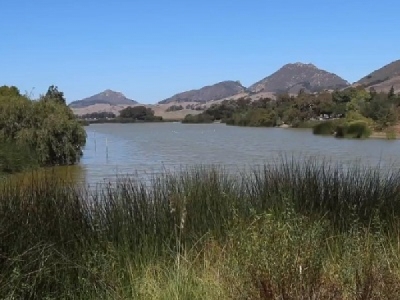
Posted on September 19, 2018
If you’re planning to visit San Luis Obispo’s Laguna Lake anytime soon, beware of harmful toxins in the water.
City officials have posted signs around the lake near Madonna Road warning that recent blue-green algae growths pose health risks to people and pets.
The warnings are:
? Don’t drink the water or use it for cooking
? Don’t let pets or other animals go in the water, drink it or eat scum on the shore
? Keep children away from algae in the water and on shore
? Stay away from algae and scum while swimming.
? Throw away the guts of fish caught in the lake and clean fish fillets with tap or bottled water before cooking
? Don’t eat shellfish caught in the lake.
Inhalation or contact with the toxic algae can result in irritation of the skin, eyes, nose and throat as well as breathing irritations, according to the Centers for Disease Control and Prevention. The toxins have been known to kill pets, but not humans.
Bob Hill, San Luis Obispo’s natural resources manager, said that blue-green algae was identified in Central Coast Regional Water Quality Control Board testing, and caution signs were first posted earlier this summer.
One possible reason for the growths? The lake’s shallower and warmer levels are conducive to algae blooms, Hill said.
SLO council considering two options for Laguna Lake dredging
“We want people to be mindful of the warnings because it can make them or their pets pretty sick,” he said.
To reduce sediments, which can contribute to a shallower lake than normal, the city is planning a limited program to dredge portions of Laguna Lake — spending $250,000 in summer 2019, $300,00 in 2020, and $350,000 in 2021.
In 2016, the city discussed spending between $5 million to $20 million on Laguna Lake dredging, with the more expensive options spanning larger swaths of the lake.
Without any dredging, levels of silt have worsened since Prefumo Creek was rerouted into the lake in the 1960s. Creekside banks have eroded, contributing to the problem.
Under normal circumstances, the lake is 7 to 9 feet deep. A major storm can add as much as a foot of sediment, though in an average year the lake experiences about 1 to 3 inches of sedimentation.
T. Keith Gurnee, running for San Luis Obispo mayor in November, said he would like to see Laguna Lake dredging become more of a priority for the city. He believes major flooding could take place without it.
Debi DeShon and her mussel-sniffing dog Popeye inspect boats at Lake Nacimiento in northern San Luis Obispo County, California, for invasive aquatic species like quagga and zebra mussels.
The City Council voted in the summer to reallocate $200,000 that had been set aside for the dredging project to spend on Laurel Lane bike and pedestrian traffic improvements. That funding that was part of other diversions from city pots to help create road improvements on the city’s south end.
“I think Laguna Lake has been neglected for far too long,” Gurnee said. “I would like to see the $200,000 that was taken away from Laguna Lake dredging for the road diet to be put back in next summer.” (That expenditure on Laguna Lake dredging would total $450,000.)
Mayor Heidi Harmon said that San Luis Obispo has taken a more cautious fiscal approach to dredging because of other spending priorities, including safer bikeways, while making up an $8.9 million shortfall due to pension costs over the 2017-2019 budget cycle.
Once the city-approved San Luis Ranch development project gets going on a 131-acre site near Madonna Road and Highway 101, Harmon said, spending more on Laguna Lake dredging might be more appropriate.
An egret stalks prey at Laguna Lake in San Luis Obispo. Toxic blue-green algae has been found in the lake and the city is warning people against coming in contact with it.
David Middlecamp dmiddlecamp@thetribunenews.com
“Given our need for fiscal responsibility, we couldn’t justify spending millions all at once on this,” said Harmon, who’s running for re-election. “Instead, we’ve taken a more step-by-step approach. We could look at spending more on this in the future after further analysis of what the community’s spending priorities are citywide.”
Source: The Tribune





